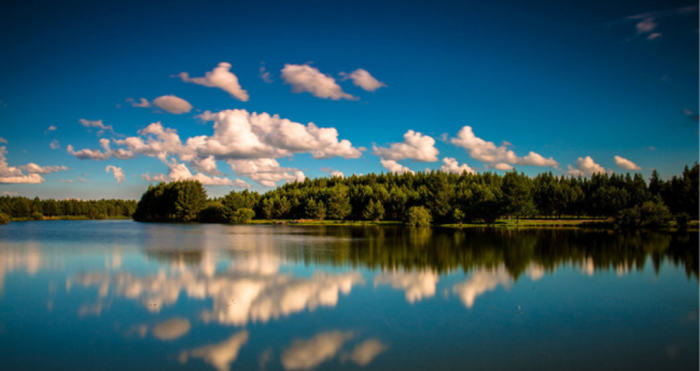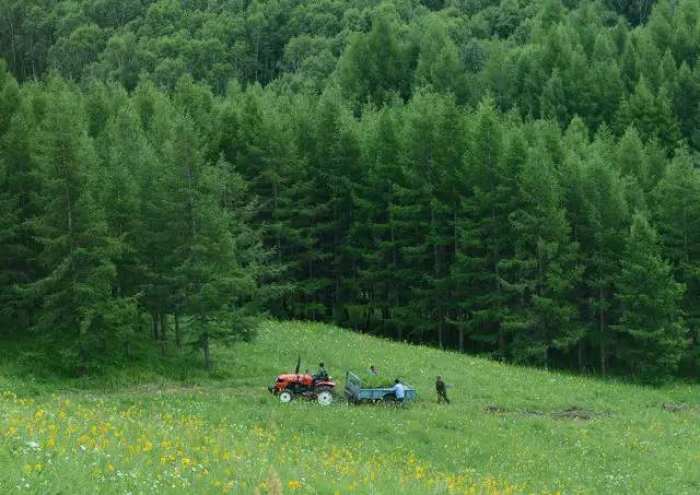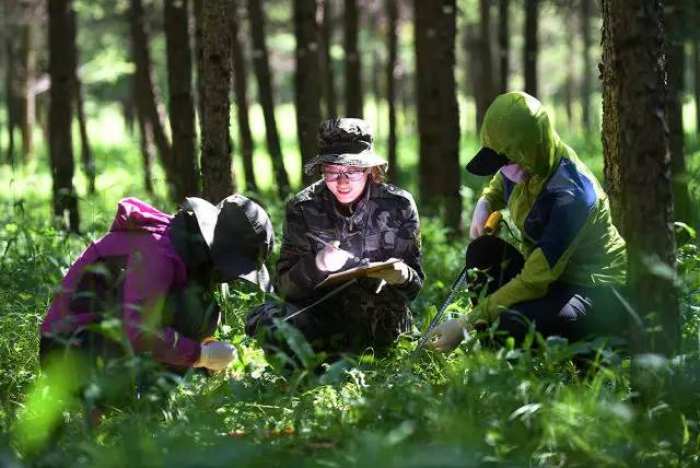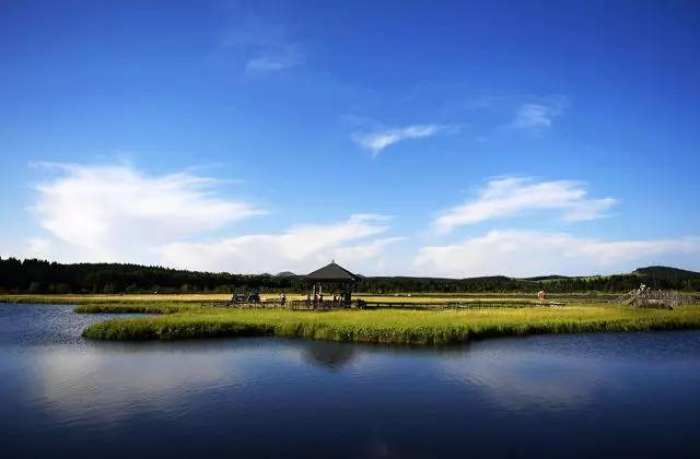


The distance between Chengde, Hebei province, and Saihanba National Forest Park, China's largest man-made woodland, is just 150 kilometers, but in September 1962, it took 18-year-old Yin Guizhi two days in an open truck to complete a journey marked by nonstop jolting and endless vistas of yellow soil dotted with thickets of trees.
"Having just graduated from a vocational school in Chengde, I asked to come here, together with two of my classmates. We were told the country was going to cultivate a forest, lush and beautiful. Just the thought of it was enough to get me onboard," said Yin, now 73.
She and her colleagues were warmly welcomed and treated to what the locals called black flour buns. Impressed more by the hospitality than the food, Yin had no idea what was to come a month later, when winter began.
"We lived in improvised shelters propped up on tree trunks and covered with twigs and straw. The glassless windows were covered with paper, and in place of doors we used large planks of wood that left big gaps on both sides," Yin said. "That was where we entered and exited our shelters, and where the winter winds came howling in."
Occasionally at night, a sleepless Yin caught glimpses of the glinting green eyes of wolves, which prowled around the shelters but didn't try to enter.
Often on winter mornings, she woke to discover her felt blanket had frozen solid to the wooden bed and she had to use a shovel to scrape it off.
Little by little, a straw mat one of Yin's colleagues used to sleep on the earthen floor became increasingly damp, indicating that the frozen ground was thawing and meltwater was seeping through.
"I felt that the debilitating cold was not only biting my toes, on which I applied soothing mashed potato, but also gnawing at any warmth I managed to retain in my heart," Yin said. "Again and again, I looked back to that vivacious young woman who just a few months before had believed she was here to stay. I tried desperately not to let reality snuff out that precious flame of hope."
For those who were at Saihanba, which means "beautiful highland", in 1962 and'63, the first two years of its existence, clinging to hope meant not only facing up to the harsher side of nature, but also to repeated failures.
More than 90 percent of the seedlings planted in those first two years died.
Saihanba, which covers 92,000 hectares and borders the southern edge of the Inner Mongolia autonomous region, was so volatile and untamable that people had forgotten that it was once regarded as one of the most beautiful places on Earth.

Hunting ground
In the 10th century, the area became a hunting ground for the rulers of Liao, an empire founded by nomadic people in North China.
Empires rose and fell, but Saihanba continued to charm. The land, composed mainly of boundless forests and grassland dotted with crystal-clear plateau lakes, remained popular with China's rulers, especially during the 17th century. Emperor Kangxi (1654-1722), the longest-reigning ruler of the Qing (1644-1911), China's last dynasty, was so smitten by the area's beauty that he hunted there. Historical records suggest that he set a personal record of 318 rabbits in a single day's hunting.
The dynasty started to wane in the early 19th century. In about 1860, the reigning emperor, with neither the funds nor the temperament to maintain extravagant hunting tours, opened the land to the public.
Farmers and herders moved in, and in the decades that followed trees were felled, the forests and grassland disappeared and the beauty of Saihanba vanished. It was the beginning of nature's revenge.
By the 1950s, Saihanba had long ceased to be a beautiful highland area 280 kilometers north of Beijing. Instead, it was a passageway through which the wind blew the sand of the deserts of Inner Mongolia all the way to the capital. According to the bleakest predictions, Beijing would be buried under sand within decades.
Yin's job was to halt the process. She was not alone: 127 graduates-mostly forestry majors-arrived from two technical schools and a college to join the 242 people who were already there.
By 1962, the surrounding area was designated a national forest.
Then, the average age of the area's 369 inhabitants was 24. Today, more than half of them have died, partly as a result of the harsh natural environment and partly because of the hard labor required to grow the forest. Their average life span was 55 years.

Breakthrough
In the early 1960s, the low survival rate of tree seedlings threatened the existence of the forest, but things began to improve in the spring of 1964.
"We wanted to make one last attempt," said Zhang Xing, 81, who has spent almost his entire life at Saihanba, as he stood on the fringes of a hoof-shaped patch of land in the northwest of the forest looking at the conifers that are now about 20 meters high. The trees, covering an area of 34 hectares, were all planted during that breakthrough spring.
"Two hundred people were in the mountains for 40 days continuously, preparing the earth for the planting of the seedlings, which took just two days," he recalled. "The trees were planted by specially adapted machines imported from what was then the Soviet Union. The roar of the machines mixed with the noise of the wind, and the dry earth, ploughed open by the machines, was swept up by the wind. The whole area was a battleground."
No battleground is without casualties.
"It was mid-April, but deep in the mountains winter was still battling for its last stronghold. We put on everything available, from cotton-padded overcoats to felt leg wraps. Ice formed on our clothes. It made a clunking sound with every move we made, turning our clothes into armor under which we sweated," he said. "Many of us, me included, developed severe rheumatism as a result."
When July arrived, the workers were overjoyed to discover a soft carpet of green shoots. That year, the survival rate topped 90 percent.

Chen Zhiqing, 45, who arrived in Saihanba in 1994, is the deputy director of the forest's management team. "The reason they failed in 1962 and '63 is because the tree seedlings they used were imported from other parts of China, especially the cold northeast. Saihanba's climate is so extreme that almost no 'outsider' could possibly survive. Moreover, long-distance transportation also resulted in the seedlings being damaged due to either severe loss of water or heat trapped inside the boxes," he said. "The seedlings planted in 1964 were all grown locally and had sturdy stems and robust roots.
"The cultivation method was changed, too: Before, mindful of the strong winds and scorching summer sun, the seedlings were put under shade. But no protected plant species could be expected to take root in Saihanba," he added. "So they eventually came up with what we now call all-light seedling cultivation, whereby the young plants, although still grown with lots of attention, were exposed to the elements."

Devastation
Despite the initial breakthrough, progress was halted several times in later years.
The workers were devastated when glazed frost hit in October 1977, destroying 38,000 hectares of forest in a single night.
Yin remembers the scene vividly.
"The moment the freezing rain fell onto the tree branches, it formed a transparent coating of ice. The tallest trees must have sustained weights of up to 250 kilograms. The long night was interrupted by the sound of cracking, as branches broke off and fell to the ground," she said.
That disaster was followed by a long drought in the 1980s and a number of plagues of insects in the '80s,'90s and 2000s. There was also a serious rat infestation in the spring of 2013.
Throughout the setbacks, the team continued to plant trees. By the end of 1982, the area under cultivation was estimated at 63,000 hectares. Today, the figure has risen to 68,000 hectares.
"With almost no flat land left, over the past five years, we've been trying to plant trees on rocky mountain slopes, where the topsoil is less than 15 centimeters thick," said Fan Dongdong, 33, who arrived in Saihanba in 2007, immediately after graduating from Hebei Agricultural University, 500 km away.
"We chose Scots pine, a species accustomed to cold, arid climates. Once established, its ever-extending roots reach deep between the rocks," he said. "But before that, we have to give the saplings a home by digging a hole about 40 cm in depth and 70 cm by 70 cm in cross section."
The process is harder than it sounds: The rocks are so large that earthmovers are used to move them. When the machines hit the rocks, the sparks and plumes of white smoke can be seen from the foot of the mountain.
"The space left is filled with black soil we take from another part of the forest. The soil is so precious-in many other parts of Saihanba, you get white sand under a thin layer of soil-that we put it in our cupped hands and pour it carefully into the hole, not wanting to waste even a pinch," Fan said. "The mountain slope is too steep for the kind of tree-planting machines used in 1964. Everything must be done by hand."
According to Fan, hand-planted trees account for 90 percent of the forest's total.
"When I first arrived, no one seriously thought I would stay, but I proved them wrong. The conditions here are a hundred times better than they were half a century ago, but it can still be testing. The winter is still forbidding, as is the loneliness," he said.
Fan lives with his young wife in the forest. They married last year and she is now seven months pregnant.

A family affair
Their story is familiar to Yin because she and her husband, Yang Maolin, met in Saihanba and married 42 years ago. They have two daughters and a son, who all work in the forest. One of their grandsons joined in 2012 after graduating from the same vocational school as his grandmother.
"Both of us came in 1962," Yin said, looking at her 75-year-old husband sitting beside her.
"Back then, we planted 2,000 conifer trees on every half-hectare, and in the years that followed we thinned out those that were not very healthy or had not grown straight. Now, we have 450 trees on each hectare-that provides enough room for every tree that has battled the hostility of Saihanba to become a monument of its own," she said.
At one end of the conifer forest stands a white bust, with a name and dates inscribed on the pedestal: "Wang Shanghai, 1921.4-1989.12."
"In 1964, he was our captain, the big uncle who never complained and who made us believe that this was going to work. He died of a cerebral hemorrhage in 1989, and was buried here," Yin said.
"Many old comrades have now gone, including some my own age. Deep in my heart, I mourn them almost every single day. But luckily, my husband is still here, and he has a promise to keep," she said. "When we got married in 1965, he promised that one day he would take me for a walk in the forest. He still hasn't."
 Fire brigade in Shanghai holds group wedding
Fire brigade in Shanghai holds group wedding Tourists enjoy ice sculptures in Datan Town, north China
Tourists enjoy ice sculptures in Datan Town, north China Sunset scenery of Dayan Pagoda in Xi'an
Sunset scenery of Dayan Pagoda in Xi'an Tourists have fun at scenic spot in Nanlong Town, NW China
Tourists have fun at scenic spot in Nanlong Town, NW China Harbin attracts tourists by making best use of ice in winter
Harbin attracts tourists by making best use of ice in winter In pics: FIS Alpine Ski Women's World Cup Slalom
In pics: FIS Alpine Ski Women's World Cup Slalom Black-necked cranes rest at reservoir in Lhunzhub County, Lhasa
Black-necked cranes rest at reservoir in Lhunzhub County, Lhasa China's FAST telescope will be available to foreign scientists in April
China's FAST telescope will be available to foreign scientists in April "She power" plays indispensable role in poverty alleviation
"She power" plays indispensable role in poverty alleviation Top 10 world news events of People's Daily in 2020
Top 10 world news events of People's Daily in 2020 Top 10 China news events of People's Daily in 2020
Top 10 China news events of People's Daily in 2020 Top 10 media buzzwords of 2020
Top 10 media buzzwords of 2020 Year-ender:10 major tourism stories of 2020
Year-ender:10 major tourism stories of 2020 No interference in Venezuelan issues
No interference in Venezuelan issues
 Biz prepares for trade spat
Biz prepares for trade spat
 Broadcasting Continent
Broadcasting Continent Australia wins Chinese CEOs as US loses
Australia wins Chinese CEOs as US loses